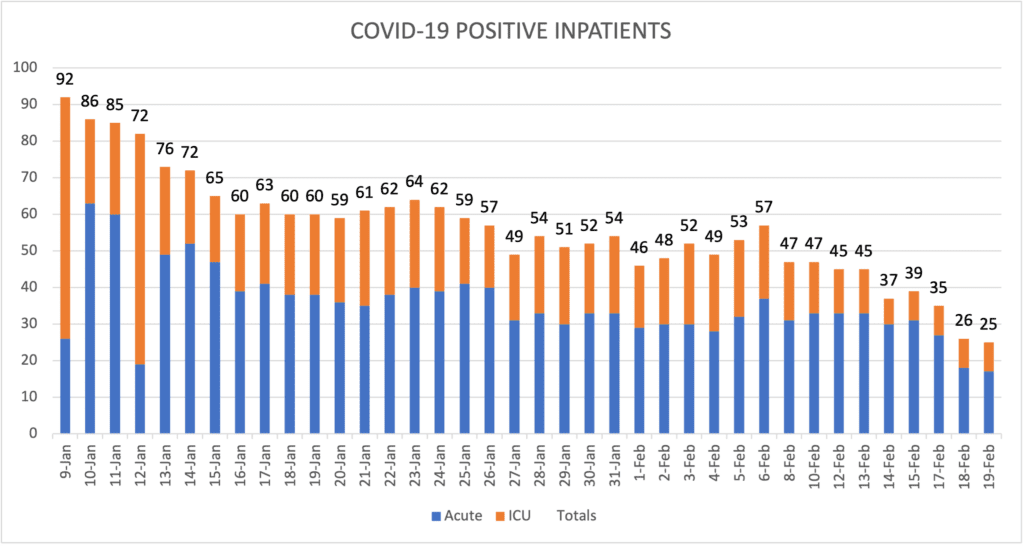Data Snapshot
UW Medicine Hospitals:

King County: The county reported 178 new positive cases and 2 new deaths on Feb. 18.
Washington: The state reported 314,655 cases and 4,803 deaths as of Feb. 17.
United States: The CDC reports 27,669,556 cases and 489,067 deaths as of Feb. 18.
Global: WHO reports 109,594,835 confirmed COVID-19 cases and 2,424,060 deaths as of Feb. 19.
Numbers update frequently, please follow links for most up-to-date numbers.
UW Medicine COVID-19 Vaccine Distribution Update
Total Vaccine Doses Administered: 88,804
- Total first dose: 58,099
- Total second dose: 30,705
As of Feb. 18, 2021.
UW Medicine in the News
HuffPost: What’s The Difference Between The New COVID-19 Variants?
Featuring: Pavitra Roychoudhury, Laboratory Medicine
“Emerging COVID-19 variants have dominated international headlines in recent months. This highlights a reality that has been clear to physicians and researchers well versed in viruses, but not necessarily to the rest of us: SARS-CoV-2 has been mutating since the pandemic began. While media reports sometimes use words like “mutation,” “strain” and “variants” interchangeably, there are differences. ‘Mutations are changes that are basically typos that occur in the genome of the virus as it makes copies of itself and moves from person to person,’ explained Pavitra Roychoudhury, a coronavirus genetics expert and instructor in the department of laboratory medicine and pathology at the University of Washington School of Medicine. ‘Variants we define as a particular version of the virus that has a specific combination of mutations across its genome,’ Roychoudhury continued. ‘A variant becomes a variant of concern when we start to see it rising in frequency over the population, over a period of time.'”
KHQ Spokane: Asked and Answered: If the vaccines aren’t a live virus, why do some people have chills, aches after getting the vaccine?
Featuring: Paul Pottinger, Allergy & Infectious Diseases
“We received the following question from Virginia: “If the vaccines are not a live virus, then why do some people have body aches, chills, and fever after receiving the first or second vaccine?” Professor of medicine in the Division of Allergy and Infectious Diseases at the University of Washington Paul Pottinger said the symptoms people feel after getting vaccinates, especially after their second dose, is a sign that the immune system is revving up and responding to the vaccine. Pottinger said this is exactly what they want to happen and says unfortunately, some of that immune response can mean people will feel lousy for about a day. He said some people don’t report any side effects, and that’s okay too. Pottinger said side effects are the antibody’s response and it just means your body is doing its job.”
The Daily: COVID-19 immune memory response lasts for over three months
Featuring: Lauren Rodda, Jason Netland, The Pepper Lab, Immunology
“Research conducted at the UW has revealed that individuals who recover from a mild case of COVID-19 develop an immune memory response lasting for at least three months. An immune memory response is the ability for the body’s immune system to quickly recognize and attack a previously-encountered virus. Thus, people are unlikely to be infected with COVID-19 again within three months of recovering from a mild case of the virus. The research was a combined effort, bringing together experts from all over Seattle and the UW to ensure results as quickly as possible. Lauren Rodda and Jason Netland, the lead authors of the study, are both researchers who work in the Pepper Lab at the UW School of Medicine. The study was conducted on 15 individuals who reported having mild symptoms of COVID-19. Participants were tested both one month and three months after their recovery. After the researchers looked at the participant’s antibodies and memory B and T cells, they found very promising results. The one-month mark showed researchers that people are able to generate an immune memory response to COVID-19, and the three-month mark indicated an ability to maintain that response.”
COVID-19 Literature Report
COVID-19 Literature Situation Report is a daily (M-F) newsletter put together by the Alliance for Pandemic Preparedness that provides a succinct summary of the latest scientific literature related to the COVID-19 pandemic.
Key Takeaways: COVID-19 Literature Situation Report Feb. 17, 2021
- The Minnesota Department of Health identified eight people who had been infected with the B.1.1.7 SARS-CoV-2 variant (first detected in the UK) from December 18, 2020–January 11, 2021. Three people had a history of international travel during the 14 days before illness onset, and three additional people had traveled domestically. More.
- During April through July 2020, there was a 19% attack rate of COVID-19 among meat processing workers in Nebraska. Implementing universal masking and physical barrier interventions reduced COVID-19 incidence in less than 10 days in 8 of 13 facilities. More.
- CD8+ T-cells from COVID-19 convalescent individuals can recognize epitopes derived from SARS-CoV-2 variants, suggesting that anti-SARS-CoV-2 CD8+ T-cell responses should recognize the newly described variants. More.
COVID-19 Literature Surveillance Team, is an affiliated group of medical students, PhDs and physicians keeping up with the latest research on SARS-CoV-2 / COVID-19 by finding the newest articles, reading them, grading their level of evidence and bringing you the bottom line.
Read the latest report: Feb. 17 | Daily COVID-19 LST Report.
Listen to the latest podcast: Feb. 8 | COVID-19 LST Podcast.
Tweet of the Week
With after-vaccine health checkers like v-safe, more data is pouring in on common side effects, or lack thereof, reports @sciam @science_ari Discussing vaccine reactions is @helenchu who tells why minor aches & fever can follow the COVID shot https://t.co/EWBS4YHAXL
— UW Medicine Newsroom (@uwmnewsroom) February 19, 2021

